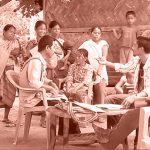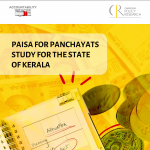
An Essential Learning Curve for Grassroots Practitioners
6 December 2019
One of the challenges we commonly face in our Learning and Development work at Accountability Initiative is of taking research to practitioners on the ground in a meaningful and engaging way, while ensuring that it is relevant, relatable and contextually valuable for them. These practitioners are mostly seasoned professionals, with rich grassroots and real-world experience, and come with strong local networks as well as a thorough understanding of their sectoral and geographical areas of work. What can we teach them that is new? Could learnings from research conducted across academia and think tanks potentially provide valuable insights to those implementing programmes in Civil Society Organisations (CSOs) across the country? Yes, says our experience.
From the response to our course – Hum Aur Humaari Sarkaar – there is much scope for learning. Evidence from research is valuable to local development practitioners in myriad ways, sometimes directly informing programme decisions. It exposes them to innovative practices counterparts around the world are adopting, and at other times, helps them look at an issue from a different lens using a theoretical framework. Through our courses, we have seen that local development practitioners learn best when classroom teaching ties in with their actual experiences of working in the social sector.
For instance, we often come across a piece of research writing that we get excited about, because we feel it resonates with the essence of our course. Such research is mostly inaccessible to our participants, and is simply not written keeping them in mind. One of the most challenging and exciting facets of our work is to break down an academic paper or a report into simpler, easy-to-understand, and contextually appropriate form for them. This requires thinking creatively about the entire piece, often needing us to ‘convert’ the idea from English into suitable and accurate Hindi. We also use eye-catching visuals to help participants relate better, interspersed with engaging examples and activities. To find the balance between disentangling complex ideas for a non-specialist audience, and yet retaining nuance in thought is key for us.
A couple of months ago, we were keen to overhaul some of the existing content on citizen participation and social accountability that we teach in the course. We realised that there had been significant fresh scholarship on the issue in recent years and our participants could benefit from exposure to some of these.
We especially wanted to share insights from a particular paper on social accountability strategies by Jonathan Fox, who has proposed the ‘sandwich strategy’ for social accountability. He argues that, in order for citizens to hold the government accountable for their performance in providing access to public services, there is a need to move away from purely citizen-led and focused interventions, which has been the dominant trend until recently. He suggests a shift towards strategies that look at combining citizen voice with governmental reforms on the other side, across levels of civil society, media, government and citizen groups.
We wanted to share this idea with our grassroots participants who work closely with the government as it could be an opportunity for them to critically reflect on their work within a larger framework, understand where they fit in, and what specific role in the accountability space they played.
During the session, participants from each organisation were given a ‘strategy sheet’, and were asked to think of themselves as leaders of their organisation and chart a vision for where they would like to take the organisation and its work. They had to keep in mind the learnings from the ‘sandwich’ strategy, and how it encourages collaborative efforts between CSOs at various levels, media organisations, citizen groups, and the government.
It is at this stage, that we saw participants really starting to engage with the content, making interconnections between theory and practice. Some of them were very excited about putting on their strategy hats, while others seemed hesitant initially, often saying that they were not the ones who took calls of this nature in their organisations. The discussions among them were insightful.
When talking about coordinated efforts as suggested in the ‘sandwich’ strategy, it was interesting to see a difference in opinion over what partnership between NGOs meant, and how formal or informal these could be in the eyes of our grassroots audience. A lot of times, participants would not realise they were collaborating with another NGO until prodded further, simply because they were unaware of a formal agreement being reached. In essence, the idea behind this activity was to get participants to critically look at their vision and work, and the impact and reach they wished to create.
In every session we have conducted this exercise, our participants have a lot of questions for the facilitating team as they try and strategise how they should best engage stakeholders in the accountability system. We hope that this amalgamation of research and practice, of new ideas and insights from a theoretical framework combined with rich experience and knowledge of the ground reality, will lead them to advocate for more innovative, concerted, and cross-cutting efforts for accountability in their work.
After all, as both researchers and practitioners increasingly realise, the value of transcending the research-practice divide will become a valuable vantage point in the future.
Aamna is a Learning and Development Associate at Accountability Initiative.
To know more about the Hum Aur Humaari Sarkaar course, visit here.





